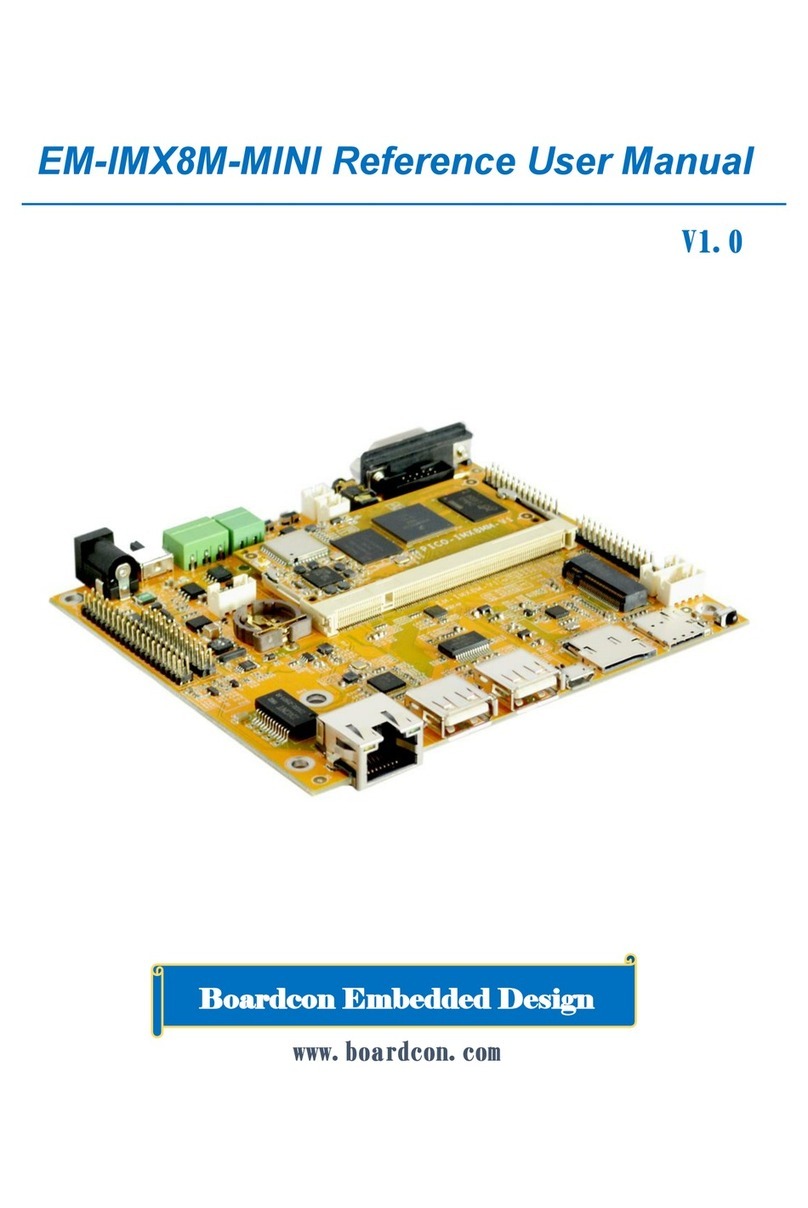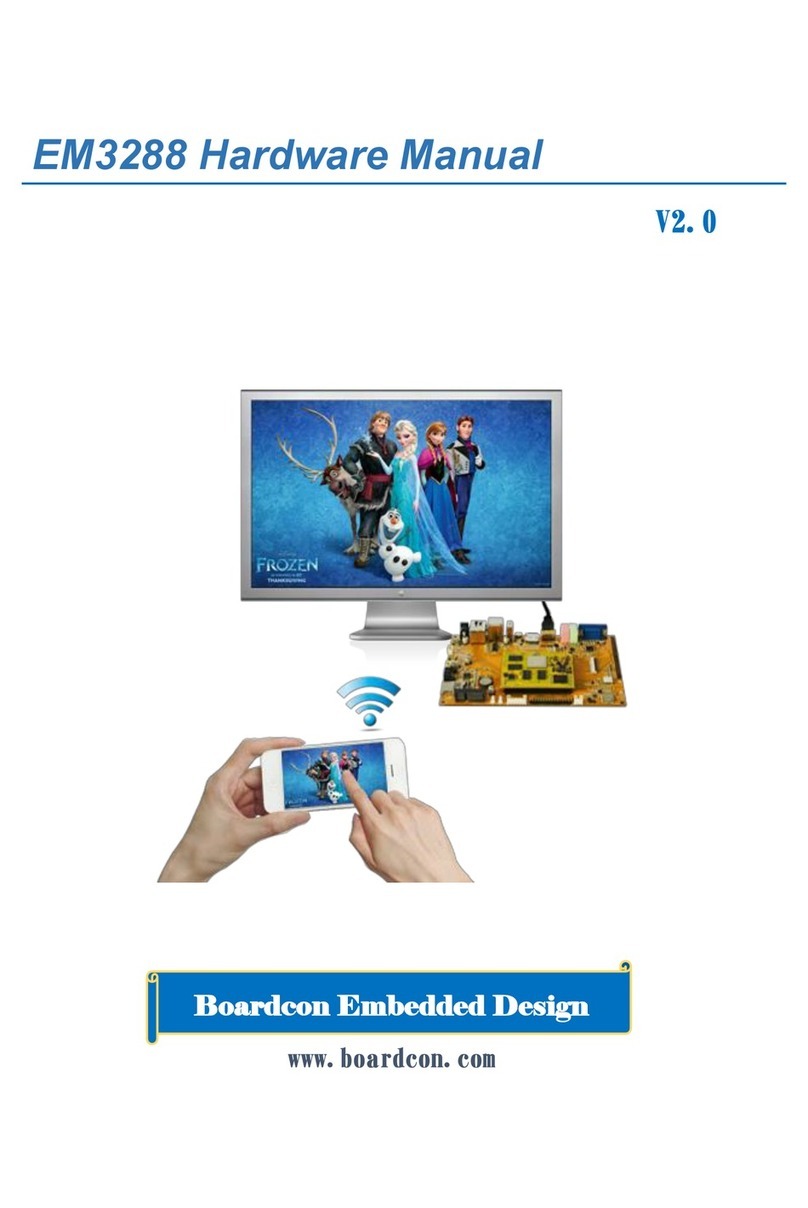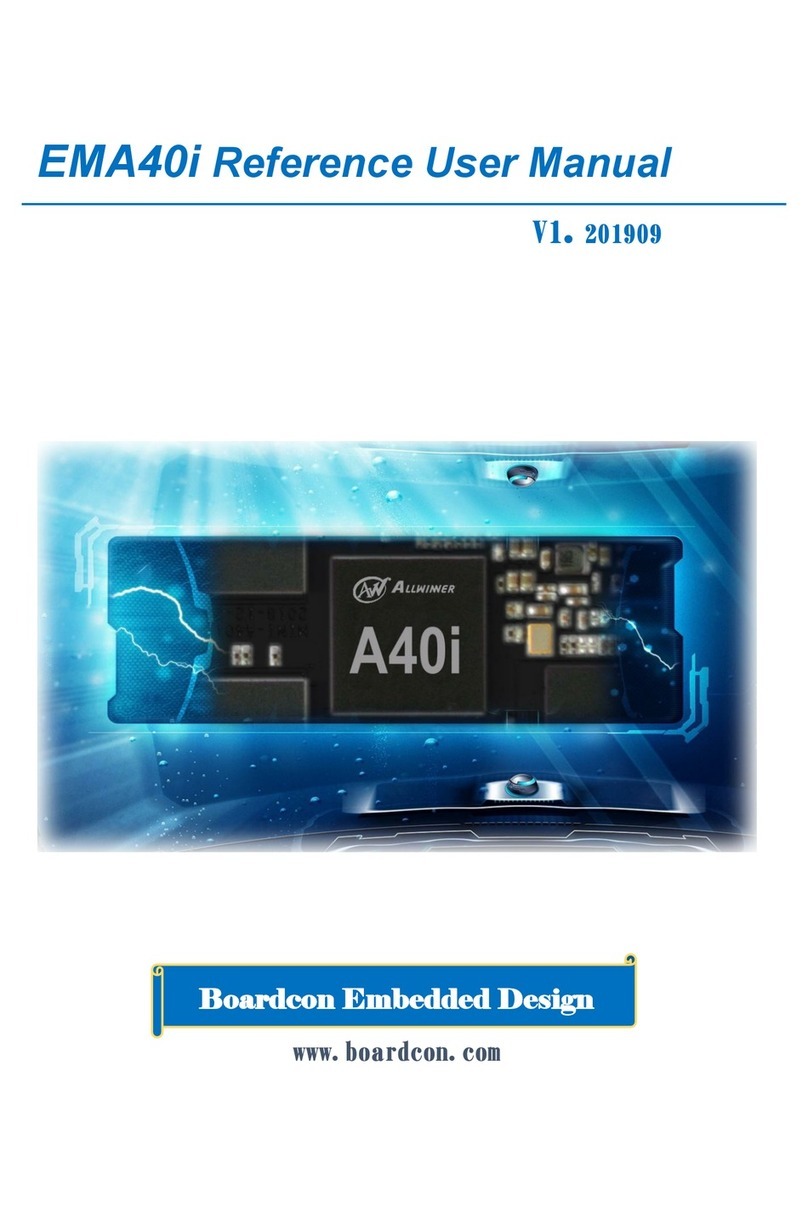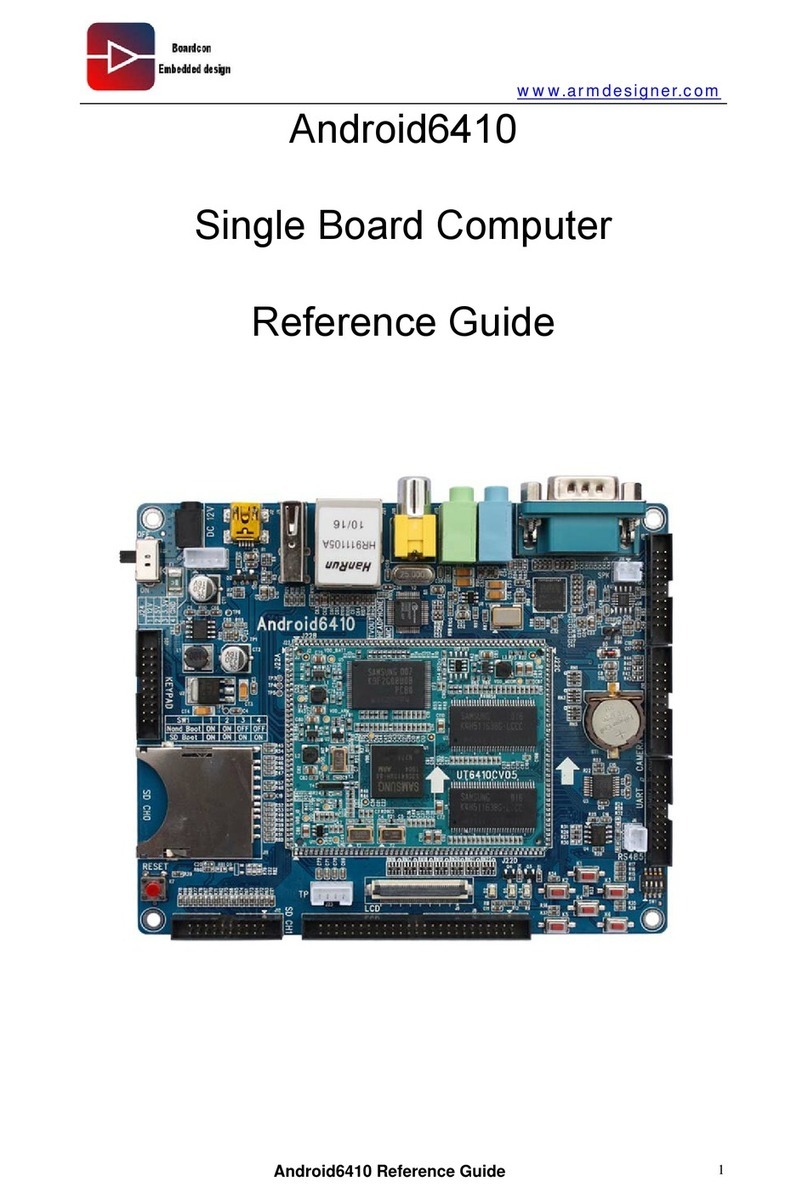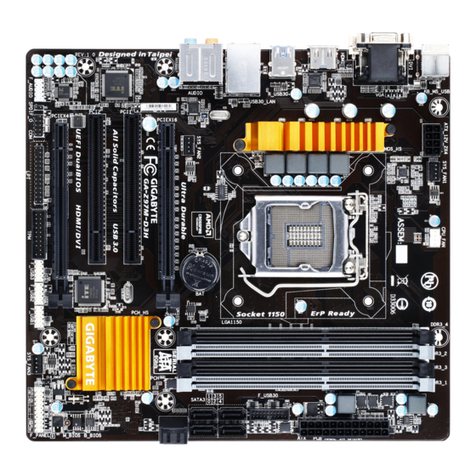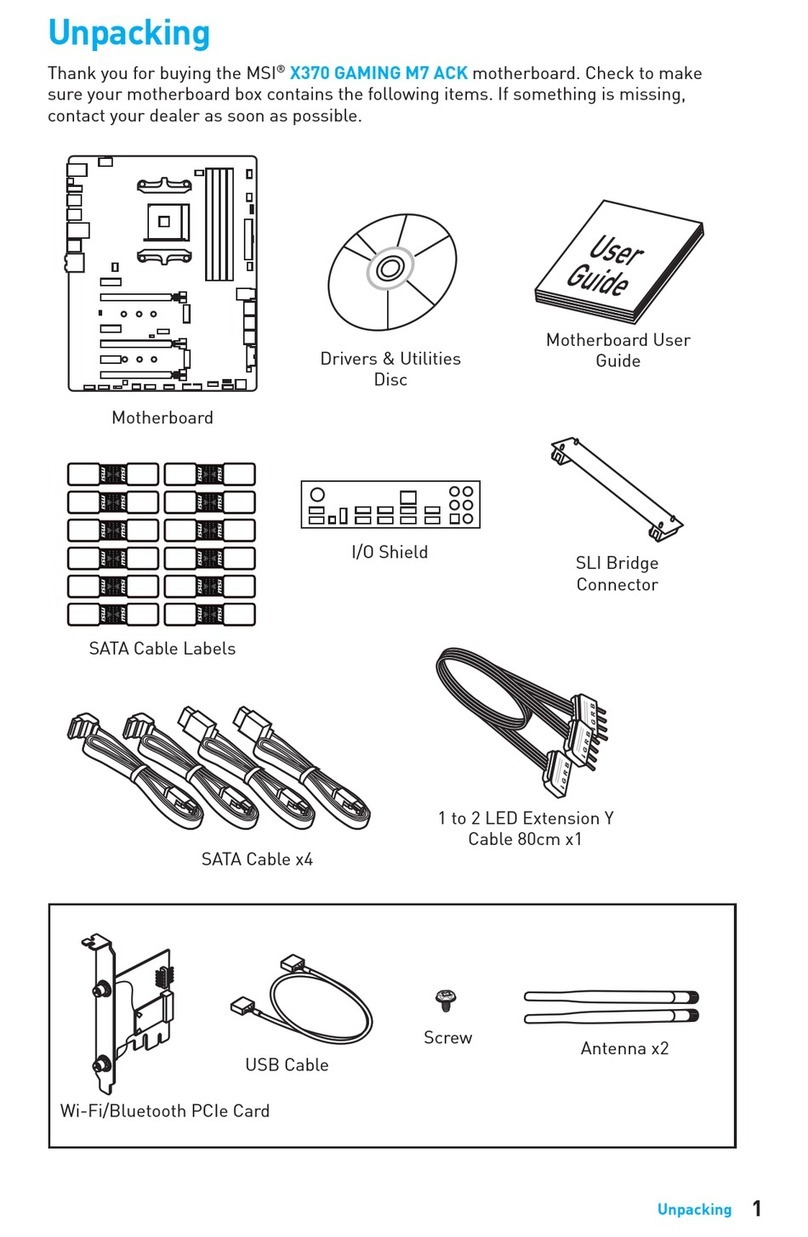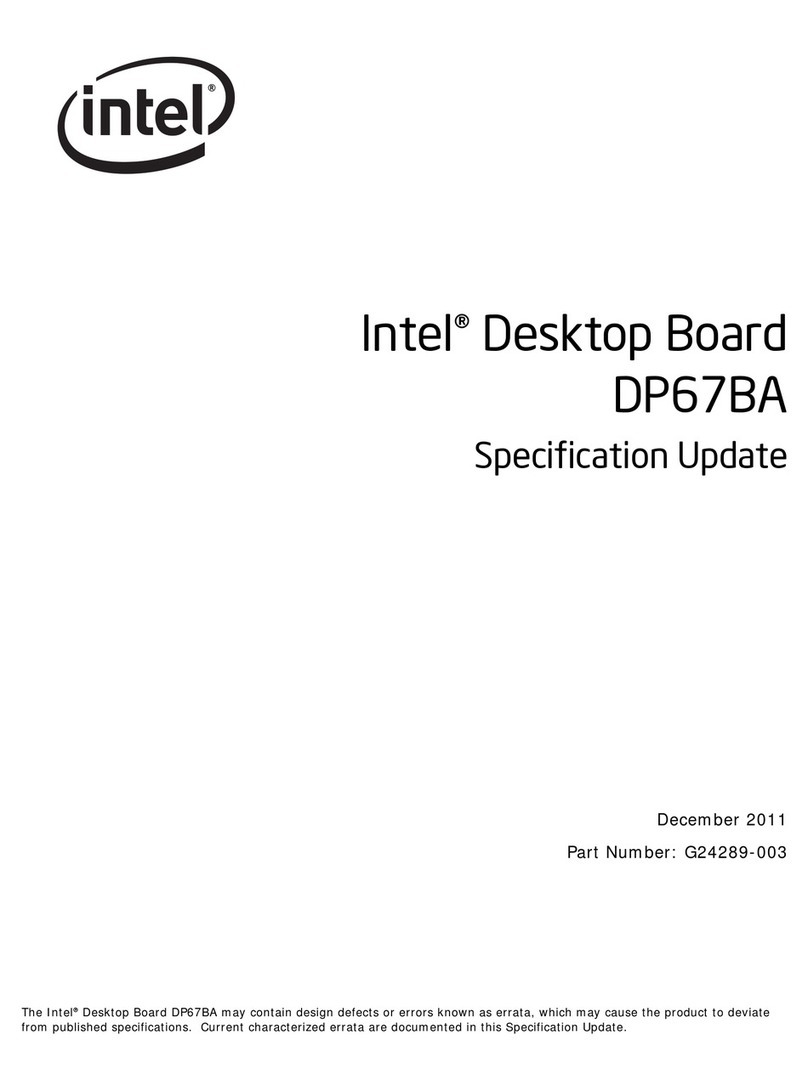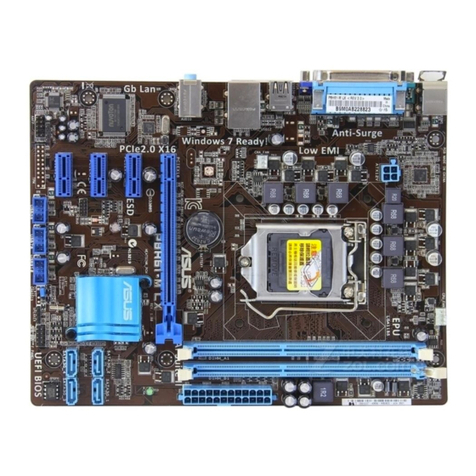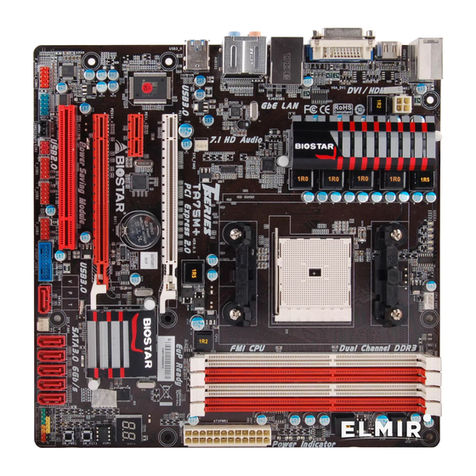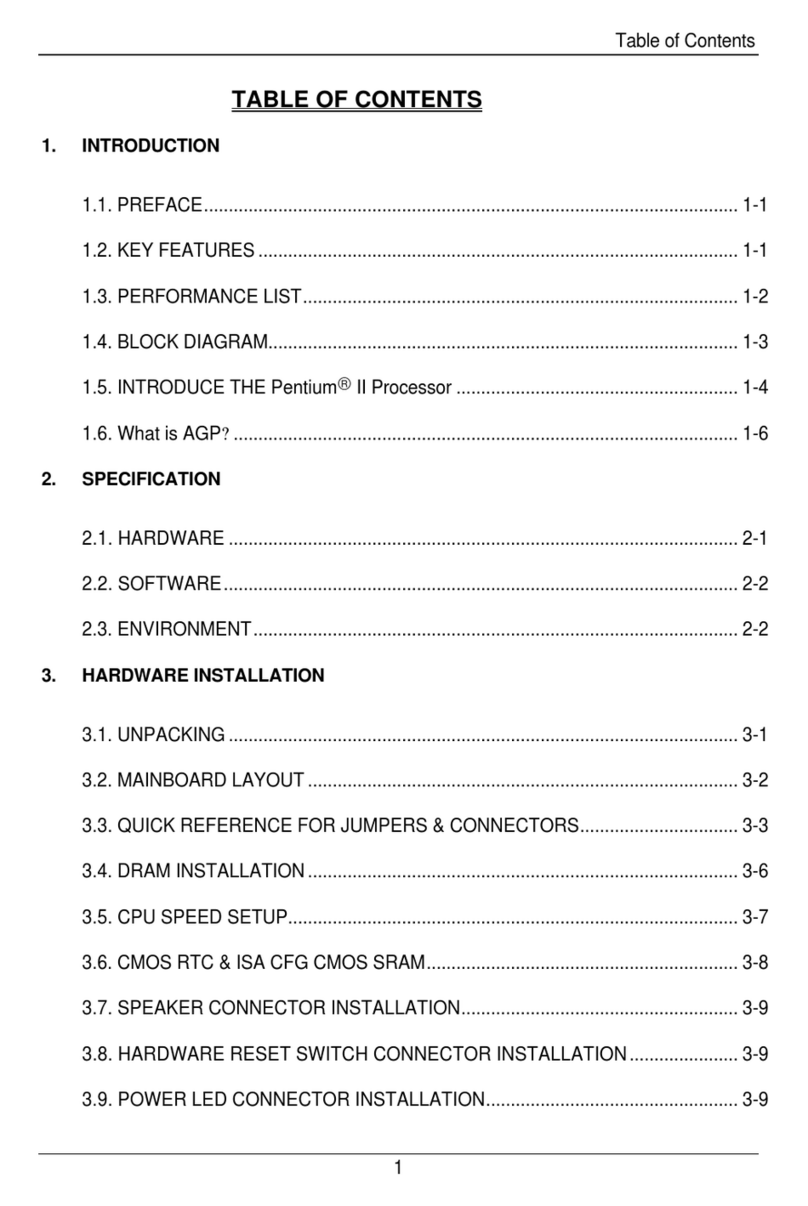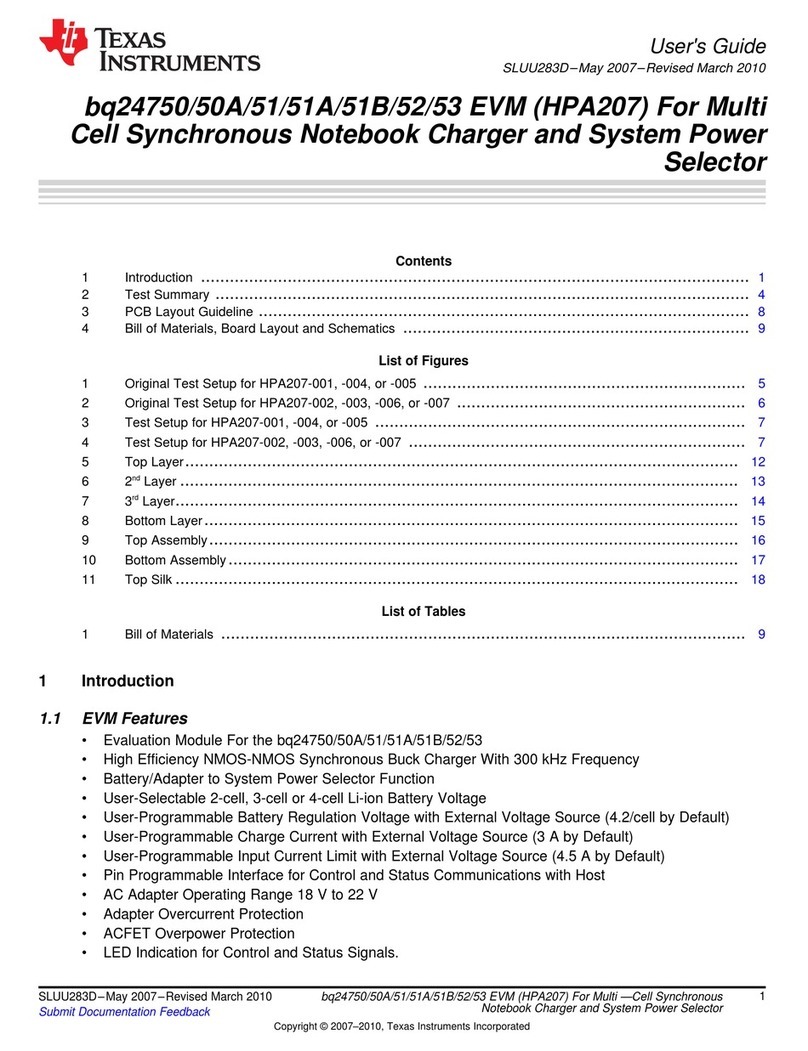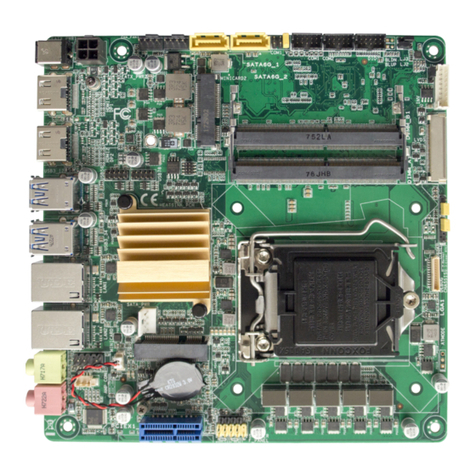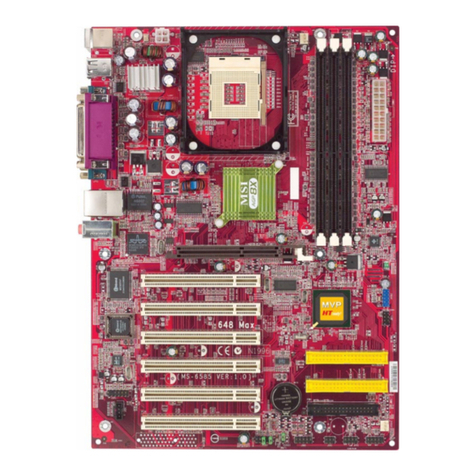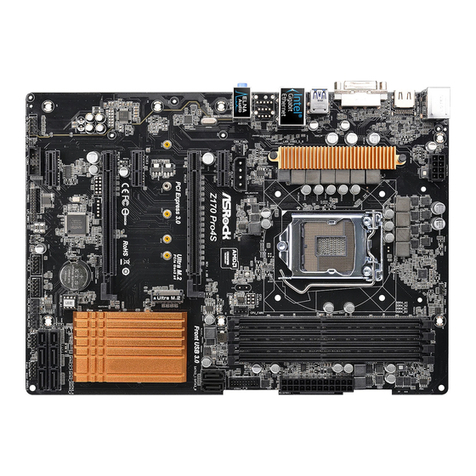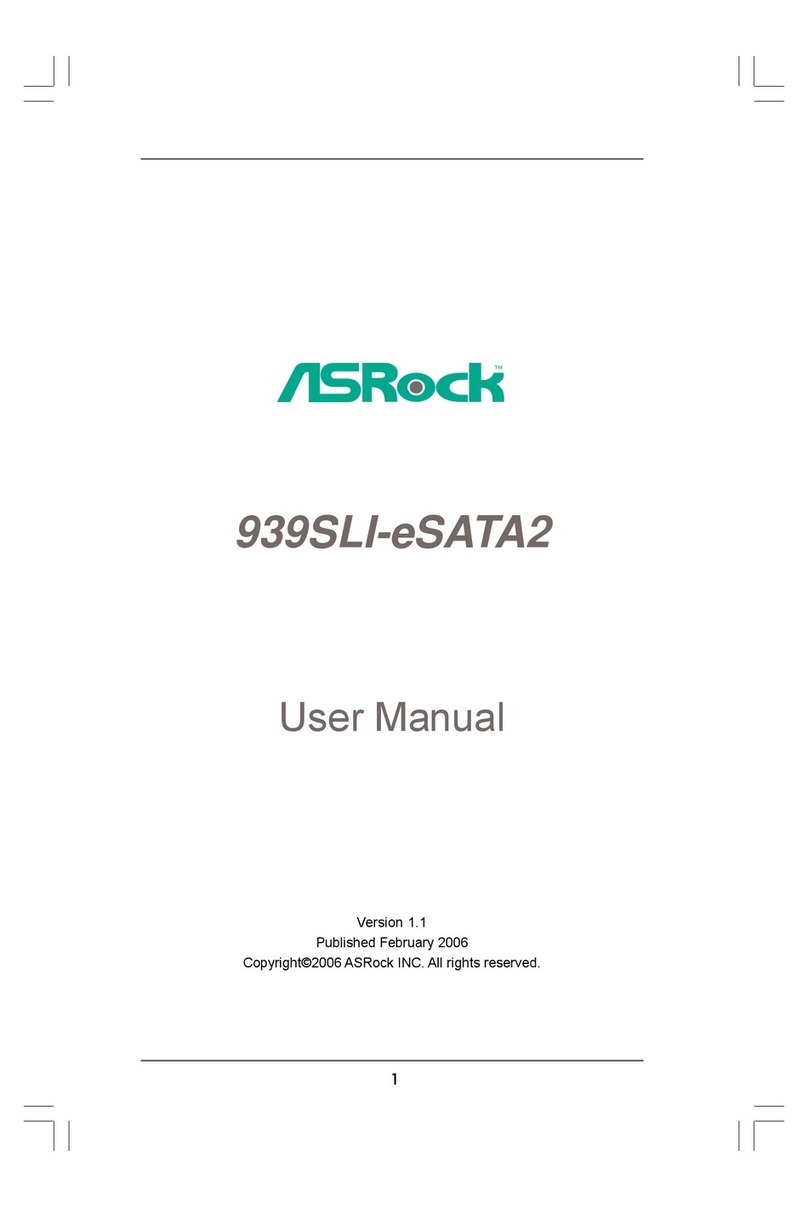Boardcon Idea6410 User manual

www.armdesigner.com
Idea6410
Single Board Computer
Hardware Reference Guide
IDEA6410 Hardware Reference Guide 1

www.armdesigner.com
IDEA6410 Hardware Reference Guide 2
1. Introduction
1.1. About this Manual
This manual is intended to provide the user with an overview of the board and benefits,
complete features specifications, and set up procedures. It contains important safety
information as well.
1.2. Feedback and Update to this Manual
To help our customers make the most of our products, we are continually making
additional and updated resources available on the Boardcon website
(www.armdesigner.com).
These include manuals, application notes, programming examples, and updated software
and hardware. Check in periodically to see what’s new!
When we are prioritizing work on these updated resources, feedback from customers is
the number one influence, If you have questions, comments, or concerns about your
product or project, please no hesitate to contact us at support@armdesigner.com.
1.3. Limited Warranty
Boardcon warrants this product to be free of defects in material and workmanship for a
period of one year from date of buy. During this warranty period Boardcon will repair or
replace the defective unit in accordance with the following process:
A copy of the original invoice must be included when returning the defective unit to
Boardcon. This limited warranty does not cover damages resulting from lighting or other
power surges, misuse, abuse, abnormal conditions of operation, or attempts to alter or
modify the function of the product.
This warranty is limited to the repair or replacement of the defective unit .In no event shall
Boardcon be liable or responsible for any loss or damages, including but not limited to any
lost profits, incidental or consequential damages, loss of business, or anticipatory profits
arising from the use or inability to use this products.
Repairs make after the expiration of the warranty period are subject to a repair charge and
the cost of return shipping. Please contact Boardcon to arrange for any repair service and
to obtain repair charge information.

www.armdesigner.com
IDEA6410 Hardware Reference Guide 3
1. OVERVIEW........................................................................................................................................4
1.1. HIGHLIGHTS ...................................................................................................................................4
1.2. IDEA6410 BLOCK DIAGRAM.........................................................................................................6
2. IDEA6410 POWER DESIGN...........................................................................................................7
2.1. POWER SUPPLY FOR IDEA6410......................................................................................................7
2.1.1. Power Supply ways............................................................................................................7
2.1.2 The Schematic drawing of power input............................................................................7
2.1.3. Voltage value on circuit dot...............................................................................................8
2.2. POWER ELECTRICAL CHARACTERISTICS AND POWER TIME SEQUENCE OF S3C6410........................9
2.3. IDEA6410 POWER SUPPLY BLOCK DIAGRAM...............................................................................11
2.4. BOOTLOADER STARTUP CONFIGURATION MODE............................................................................12
3. IDEA6410 HARDWARE DESIGN AND INTERFACES DESCRIPTION ................................14
3.1. NAND FLASH................................................................................................................................14
3.2. DDR RAM...................................................................................................................................15
3.3. NOR FLASH ..................................................................................................................................15
3.4. SERIAL INTERFACE .......................................................................................................................16
4. INTERFACE.....................................................................................................................................19
4.1. USB HOST....................................................................................................................................19
4.2. USB OTG....................................................................................................................................20
4.3. JTAG............................................................................................................................................20
4.4. SD CARD......................................................................................................................................22
4.5. CAMERA INTERFACES ...................................................................................................................22
4.6. TFT LCDAND TOUCH SCREEN INTERFACE ..................................................................................24
4.7. RESET KEY ...................................................................................................................................26
4.8.AUDIO INTERFACE ........................................................................................................................28
4.9. BUZZER........................................................................................................................................29
4.10. 100M ETHERNET INTERFACE......................................................................................................31
4.12. TVOUT INTERFACE....................................................................................................................33
4.11. HIGH SPEED SPI, MMC2AND I2C INTERFACE ...........................................................................33
4.12. USER BUTTONS AND LEDS.........................................................................................................34
4.13. GPIOAND ADC.........................................................................................................................35
4.14. RTC ...........................................................................................................................................37
4.15. 8X8MATRIX KEYBOARD............................................................................................................38
5. OPTIONAL MODULES..................................................................................................................40
5.1.WIFI MODULE .............................................................................................................................40
5.2. GPS MODULE...............................................................................................................................40
5.3. CAMERA MODULE........................................................................................................................40
5.4. 7INCH TFTLCD MODULE...........................................................................................................40
5.5. 4*4 MATRIX KEYBOARD AND USB_HUB MODULE.....................................................................41

www.armdesigner.com
IDEA6410 Hardware Reference Guide 4
1. Overview
The Idea6410 is a compact full-featured Embedded Single Board Computer(SBC) based
upon Samsung ARM11 S3C6410, designed specifically for Mobile Internet Device ,
Notebook, handheld / 3G mobile implementations. Its functional contents are similar to the
latest generation of Pocket PC's and smartphones, This computer allows easy embedded
application development through PC-Compatible tools and methods, while ensuring
in-field reliability and ruggedness for end-user systems.Idea6410 run without fans or heat
sinks in the temperature range of -20° to +70°C. Other chip-level features include 4
UARTs, SPI, I2C, a real-time clock with a separate power domain, and NAND Flash and
DDR memory controllers. These features make the devices particularly suitable for
automotive and industrial control applications as well as medical systems. In addition to
Windows Embedded CE 6.0 and Linux2.6 support,ready-to-run Android and Ubuntu are
available from Boardcon.
1.1. Highlights
.Rugged Single Board Computer(120mmx58mm) achieved through modern SMD
technology
. Improved interference safety achieved through multi-layer PCB technology and
dedicated ground pins
.Controller signals and ports extend to connectors aligning two sides of the board
.Four Ready-to-Run software package: WinCE6.0, Linux2.6.24, Android and Ubuntu
.Working temperature: -20°C to 70°C
.Processor: Samsung S3C6410, ARM1176JZF-S, up to 667MHz.
. Power supply: +12V
. 128MB Mobile DDR SDRAM, 133MHz, 32bit, Samsung K4X51163PC
.256MB NAND Flash, 8bit, Samsung K2F2G08
.2M Bytes NOR Flash, AMD AM29LV160DB
.SDIO WIFI Module, supporting IEEE802.11b/g
.LCD/Touch Screen interface. Supporting 3.5 inch TFT LCD, 4.3 inch TFT LCD and 7
inch TFT LCD.
. Many modules are available for your choice- GPS, WIFI, Camera, USB HUB+4x4
Matrix Keyboard.
. 24 GPIO, ADC, SPI,IIC and MMC connectors
. One audio input interface (3.5mm audio jack)
.One 2-channel audio output interface (3.5mm audio jack)
. One 100M Ethernet interface (RJ45)
.One USB2.0 Device port (Mini USB type interface)

www.armdesigner.com
IDEA6410 Hardware Reference Guide 5
.Four serial ports (Two are five-wire RS-232 DB9 interface, another two are three-wire
TTL serial port led out from a 20-pin expansion connector )
.SD/MMC interface (supports 3.3V and 1.8V logic voltage)
. Camera interface (10x2 pins header, supporting the mode of ITU-R 601/656 8bit)
. One 5x2 pins JTAG interface
. Seven buttons (Reset, Boot, User defined, On/Off)
.TVOUT

www.armdesigner.com
1.2. IDEA6410 Block Diagram
IDEA6410 Hardware Reference Guide 6

www.armdesigner.com
2. IDEA6410 Power design
2.1. Power Supply for IDEA6410
2.1.1. Power Supply ways
The IDEA6410 power design adopts distributed fabric, adopting absolute power chip to
power supply respective for S3C6410 and peripheral devices.
The main chip S3C6410 runs on frequency at 533MHz, the CPU board is supplying power
for CPU with 1.1V ARM Kernel power VDD_ARM, 1.3V PLL-VCC and startup power of the
chip internal logic power VDD_xPLL and VDD_INT ,1.2V startup power VDD_Alive, 1.8V
DDR memory VDD_MEM, 3.3V I/O and the other peripheral devices.
There are two ways for power supply for IDEA6410 Single Board Computer.
(1). Using Power Adapter through mini DC_IN connector J24 to send 12V/2A to the board
(2). Using Battery 5V/3A through connector J25 to power supply.
Below picture-2 shows the two connectors:
Picuture-2
2.1.2 The Schematic drawing of power input
IDEA6410 Hardware Reference Guide 7

www.armdesigner.com
Below picture-3 shows the schematic drawing.
Picture-3
2.1.3. Voltage value on circuit dot
. VDD_5V: 5V,
VDD_IO: 3.3V
VDD_OTG: 3.3V
VDD_OTGI: 1.2V
VDD_Alive: 1.2V
VDD_INT: 1.3V
VDD_ARM: 1.2V
VDD_RTC: 3V
VDD_ADC: 3.3V
VDD_MDDR: 1.8V
VDD_AC97:3.3V
VDD_WIFI: 3.3V
IDEA6410 Hardware Reference Guide 8

www.armdesigner.com
2.2. Power electrical characteristics and power time sequence of S3C6410
IDEA6410 Hardware Reference Guide 9

www.armdesigner.com
IDEA6410 Hardware Reference Guide 10

www.armdesigner.com
2.3. IDEA6410 Power Supply block diagram
IDEA6410 Hardware Reference Guide 11

www.armdesigner.com
IDEA6410 Hardware Reference Guide 12
2.4.Bootloader startup configuration mode
The main chip S3C6410 supports many kinds of startup mode such as Nand Flash, Nor
Flash, OneNand and SD Card and so on. It selects startup device and mode through
configuring different pins' status when the system started. Below figure 2.5 shows the
startup mode of S3C6410.
XSELNAND ON[4:1] EINT[15:13] Boo-up Device Note
1 0000 XXX Nand Flash 512k page size,
addressing cycle
is 3 clock
1 0001 XXX Nand Flash 512k page size,
addressing cycle
is 4 clock
1 0010 XXX Nand Flash 2048k page size,
addressing cycle
is 4 clock
1 0011 XXX Nand Flash 2048k page size,
addressing cycle
is 5 clock
X 0100 XXX SROM(8bit) -
X 0101 XXX SROM(16bit) -
0 0110 XXX OneNand Can not use Nand
Flash
X 0111 XXX Modem SCn2 can not be
connected with
SROM
X 1111 000 Internal ROM SD
access0 -
X 1111 001 Internal ROM OneNand -
1 1111 010 Internal ROM
Nand
Flash
512k page size,
addressing cycle
is 3 clock
1 1111 011 Internal ROM
Nand
Flash
512k page size,
addressing cycle
is 4 clock
1 1111 100 Internal ROM
Nand
Flash
2048k page size,
addressing cycle
is 4 clock
1 1111 101 Internal ROM
Nand
Flash
2048k page size,
addressing cycle
is 5 clock

www.armdesigner.com
1 1111 110 Internal ROM
Nand
Flash
4096k page size,
addressing cycle
is 5 clock
X 1111 111 Internal ROM
SD
access1 -
Figure-2.5
IDEA6410 Supports NOR Flash, Nand Flash, SD Card startup mode, please see the blue
part of above picture. Also the picture-2.6 is a part of IDEA6410 startup mode.
Picture-2.6
On above picture-2.6, “OM0” is chip S3C6410 clock source select signal. It selects
“XTIpll “ when “OM0” is “0”, it select “EXTCLK” when “OM0” is “1”. The IDEA6410 uses
“XTIpll”.
“SELNAND” is a signal of selecting memory type, it is high level when selects NAND Flash,
it is low level when selects ONENAND. IDEA6410 uses NAND Flash.
EINT13-EINT15 are device selected pins of IROM startup mode, when adopts IROM
startup mode, the main chip S3C6410 runs settled program in advance then reads
EINT15,EINT14,EINT13 three pins' status with different configuration to select startup
device, the detailed configuration please see figure-2.5.
It is IROM startup mode when user selected SD Card as startup device. At this mode,
EINT15, EINT14, EINT13 are low level. So the user will see on IDEA6410 ,there signals
EINT15,EINT14,EINT13 are directly connected ground.
DBGSEL is JTAG interface call select signal, about it detail, please see the chapter 4.3.
On IDEA6410 Single Board Computer, the three pins EINT13-15 had been set into low
level, please select startup mode by configuring OM1-OM4 and SELNAND, the switch
SW1 moves to subject place, please see below figure-2.5 of SW1 configuration.
IDEA6410 Hardware Reference Guide 13

www.armdesigner.com
Ports OM1 OM2 OM3 OM4
SW1’s Position 1 2 3 4
Nor Flash boot-up 1 0 1 0
Nand Flash boot-up 1 1 0 0
SD boot-up 1 1 1 1
Figure-2.5
Note: a. “1” is SW1 ON, “0” is SW1 OFF, “X” is high level or low level.
b. The default startup mode of IDEA6410 is NAND Flash.
Below is a picture-2.7 about SW1.
Picture-2.7
OM0 is chip S3C6410 clock source select signal. It selects XTIpll when OM0 is “o”, it
select EXTCLK when OM0 is “1”. The IDEA6410 uses XTIpll.
3. IDEA6410 Hardware Design and interfaces description
3.1. Nand Flash
IDEA6410 Single Board Computer selected SLC Nand FLASH K9F2G08 from Samsung,
its size is 256M Bytes, mainly for storage Kernel, application, file system and user data.
Additionally, may parts that are footprint and functionally compatible with the Nand Flash
devices listed above may also be used with the IDEA6410.
As of the printing of this manual, these NAND Flash devices generally have a life
expectancy of at least 100,000 erase/program cycles and a data retention rate of 10
IDEA6410 Hardware Reference Guide 14

www.armdesigner.com
years.
Nand FLASH is a startup device, when startup the main chip S3C6410 automatically copy
the former 8K bites code in Nand Flash to the chip’s internal Stepping Stone room for
running. After initialization configuration, the chip jumps to start address of Kernel to run
the OS. Below picture shows the schematic drawing of Nand Flash:
3.2. DDR RAM
The IDEA6410 adopts two Samsung K4X51163PC 64M Bytes Mobile DDR RAM with
266MHz. They are small BGA package in order to save the room of the board, also is to
use same length circuit line on the PCB for guaranteeing the board running with high
speed and stably.
3.3. Nor Flash
IDEA6410 adopts ARM AM29LV160DB Nor Flash, the chip S3C6410 maximum supports
27 pieces address singals A0-A26, in which A20-A26 is reused with DDR data signals
D20-D26. As IDEA6410 adopted 32bit DDR RAM, there are only 19 pieces lineA1-A19 for
NOR Flash use. Nor Flash addressing range is 1M Bytes.
Nor Flash can be configured as startup device, it adopts 16-bit SROM startup mode.
Below picture shows the schematic drawing of NOR Flash:
IDEA6410 Hardware Reference Guide 15

www.armdesigner.com
IDEA6410 Hardware Reference Guide 16
3.4. Serial Interface
There are four Serial interfaces, UART0, UART1 is 5 lines, UART2, UART3 is 3 lines.
The board uses three pieces SP3232 serial interface chip to change the four serial
interfaces to RS232 level. The user can use switch SW2 to change the output of serial
interface into RS232 or TTL level. There is one piece of standard DB9 port at connector J4,
which is specially design for debugging and printing debugging message. Below picture
shows circuit of UART0

www.armdesigner.com
IDEA6410 Hardware Reference Guide 17
UART1, UART2 or UART3 can be set output into RS232 or TTL by adjusting switch SW2.
The pin header J6, J7, J8 is corresponding to UART1, UART2, UART3 for selecting
RS232 output, pin header J5 is TTL output for UART1, UART2, UART3. Below picture
shows those pin header connectors.

www.armdesigner.com
Below picture is circuit drawing of UART1,UAR2,UART3
IDEA6410 Hardware Reference Guide 18

www.armdesigner.com
The states of Serial interface output controlled switch SW2, please see below figure
SW2’s corresponding
Place 1-4 bit 5-6 bit 7-8 bit
UART1 TTL output 0 x x
UART1 RS232 output 1 x x
UART2 TTL output x 0 x
UART2 RS232 output x 1 x
UART3 TTL output x x 0
UART3 RS232 output x x 1
Note: It is “1” when SW2 is put on “ON”, it is “0” when SW2 is put on “OFF” , “x” means
that the output can not be fixed.
4. Interface
4.1. USB Host
USB Host interface supports USB2.0 Full speed and its port isA type/
The port supports U-Disk, USB Keyboard, USB Portal Disc, USB Mouse.
Below is its circuit drawing of USB Host.
IDEA6410 Hardware Reference Guide 19

www.armdesigner.com
4.2. USB OTG
The controller supports the On-The-Go (OTG) feature. The Universal Serial Bus OTG is a
device capable to initiate the session, control the connection and exchange
Host/Peripheral roles between each other.
USB OTG supports USB 2.0 protocol, it supports High speed(480Mbps), Full
speed(12Mbps), low speed(1.5Mbps) data rates. The IDEA6410 default runs on high
speed and slave mode for conveniently connecting with PC. It can use USB OTG to
download program or application when the user in the development.
The USB OTG port type is Mini A/B, below picture is its circuit drawing.
4.3. JTAG
The IDEA6410 is equipped with a JTAG interface for downloading program code into the
external flash, internal controller RAM or for debugging programs currently executing. The
JTAG interface extends out to a 5*2 2.0mm pitch pin header J2. Via configuring the signal
DBGSEL the user can select to operate external Flash or internal controller RAM, below is
the detail configuration of signal DBGSEL.
.When DBGSEL is set as high level, JTAG connects internal controller RAM and can
call on the address of internal controller SRAM.
. When DBGSEL is set as low level, JTAG connects external flash for debugging
programs.
IDEA6410 Hardware Reference Guide 20
Table of contents
Other Boardcon Motherboard manuals
